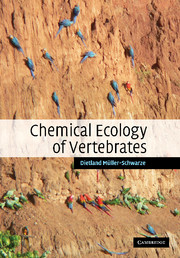Book contents
- Frontmatter
- Contents
- Preface
- Acknowledgements
- 1 The odorsphere: the environment for transmission of chemical signals
- 2 Properties of vertebrate semiochemicals
- 3 Odor production and release
- 4 Chemical cues in orientation and navigation
- 5 Chemoreception
- 6 Signaling pheromones I: discrimination and recognition
- 7 Signaling pheromones II: sex and alarm pheromones and evolutionary considerations
- 8 Intraspecific signals: priming pheromones
- 9 Development of intra- and interspecific chemical communication
- 10 Allomones I: chemical defense by animals
- 11 Allomones II: plant chemical defenses against herbivores
- 12 Kairomones and synomones
- 13 Practical applications of semiochemicals
- Glosssary
- References
- Index
8 - Intraspecific signals: priming pheromones
Published online by Cambridge University Press: 23 November 2009
- Frontmatter
- Contents
- Preface
- Acknowledgements
- 1 The odorsphere: the environment for transmission of chemical signals
- 2 Properties of vertebrate semiochemicals
- 3 Odor production and release
- 4 Chemical cues in orientation and navigation
- 5 Chemoreception
- 6 Signaling pheromones I: discrimination and recognition
- 7 Signaling pheromones II: sex and alarm pheromones and evolutionary considerations
- 8 Intraspecific signals: priming pheromones
- 9 Development of intra- and interspecific chemical communication
- 10 Allomones I: chemical defense by animals
- 11 Allomones II: plant chemical defenses against herbivores
- 12 Kairomones and synomones
- 13 Practical applications of semiochemicals
- Glosssary
- References
- Index
Summary
As the males of most animals search for the females, these odoriferous glands probably serve to excite or charm the female, rather than to guide her to the spot where the male may be found.
charles darwin (1896) Descent of Man and Selection in Relation to Sex, p. 352In the rat, olfactory communication results in the synchronization of estrous cycles within a female social group: the majority of females are likely to be at the same phase of their estrous cycles on the same day.
martha mcclintock, (1983) Chemical Signals in Vertebrates, vol. 3, p. 159Priming pheromones are intraspecific chemical stimuli that act on the endocrine system and set in motion slower and often long-lasting processes of growth, maturation, or reproductive state. The difference between signaling and priming pheromones is one of degree. Behavioral responses to pheromones can also be slow and/or are based on physiological changes. Finally, the same compound(s) may release a behavior and also set in motion a physiological response, as occurs in fish and in pigs, for example.
Fish reproduction
Effects of female pheromones on males
In fish reproduction, the best-investigated pheromone system is that of the goldfish (Carassius auratus). Here, sex steroids and prostaglandins play important roles. The female produces two pheromones sequentially: a preovulatory primer pheromone and a postovulatory prostaglandin pheromone that act on the male.
Female goldfish have an increased level of 17α, 20β-dihydroxy-4- pregnen-3-one (17, 20βP) in their blood at the time of final maturation of their oocytes (i.e. 10 hours before ovulation and spawning). The pheromone is released across the gill.
- Type
- Chapter
- Information
- Chemical Ecology of Vertebrates , pp. 203 - 226Publisher: Cambridge University PressPrint publication year: 2006



